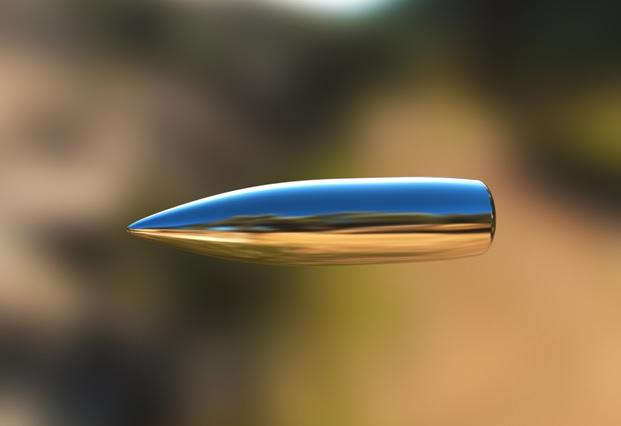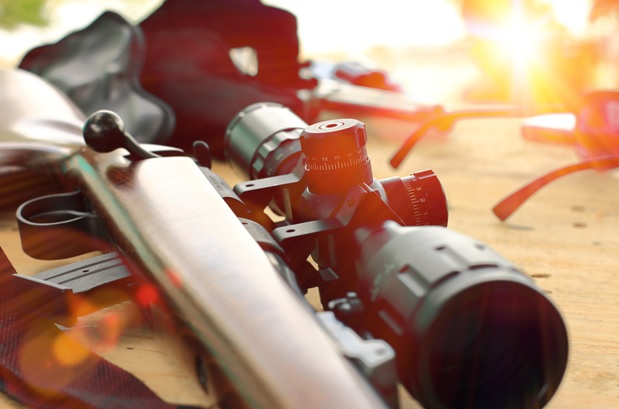Take a look at the listing on our website for the following American Eagle .223 ammo.
One of the most prominent features of this Federal ammunition is that it is loaded with boat-tailed bullets.
What are these, and what’s the deal?
First Off, What Is a Boat-Tailed Bullet?

Take a look at that sailboat in the image above. Pay attention to the shape of its cross-section.
Now take a look at the rifle bullet below. Do you notice any similarities?

It’s just a concept image - not an image of an actual American Eagle .223 bullet - but look closely at the base.
Notice how both the base of the bullet and the stern of the sailboat in the image above are pinched in?
Well, that explains the name, and the shape of a boat-tailed bullet. Now let’s take a look at why this matters.
The Origin (and Function) of Boat-Tailed Bullets
The first bullets were round balls, patched and fired from black powder, muzzleloading arms. Black powder deflagrates slowly compared to modern smokeless powders, and round balls are not ballistically or aerodynamically efficient anyway, so bullet design wasn’t a problem until the end of the 1800s, when arms manufacturers started to produce much faster-burning smokeless powder and loading cartridges with spitzer bullets that were aerodynamically efficient enough to take advantage of 1500 FPS muzzle velocities - and even higher.
Believe it or not, boat-tailed bullets are actually nothing new. They have their origins in a design pioneered by the French well over 100 years ago in 1898.
The problem arose from the production of flat-based projectiles. As arms engineers pushed the limits of powder charges and bullet speed, they noticed that the flat base of some bullet designs was actually a detriment.
The problem has to do with the production of a vacuum in the wake of the bullet.
As the bullet moves through the air, it leaves a vacuum in its wake that has to fill in behind it with air. This creates drag. At low speeds this is hardly detrimental, but at higher muzzle velocities, it starts to weigh heavily on bullet speed and performance, and particularly on effective range.
The solution is the boat-tailed bullet, in which the base is much narrower - not unlike the stern of a sailboat.
The boat-tailed design still creates a vacuum as it moves through the air, but it’s much smaller than the vacuum produced by a flat-based bullet. The slipstream is much narrower, which means not only are higher muzzle velocities more feasible, but that the bullet maintains that velocity - and therefore kinetic energy - over greater rangers.
The boat-tailed bullet design raises a bullet’s ballistic coefficient, which is a metric that indicates how well the bullet overcomes air resistance. The higher the ballistic coefficient, the more the bullet will maintain muzzle velocity downrange, which equates to a flatter trajectory and preserved energy at the point of impact.
Another benefit of a higher ballistic coefficient, which itself is a product of the boat-tailed design, is improved ability to resist wind deflection. Wind deflection alters the trajectory of a bullet and can knock it off its course. The better the bullet resists deflection, the more accurate it will be at longer ranges, as well.

How Do Shooters Benefit From This Aspect of American Eagle .223?
To summarize the advantages of boat-tailed bullets, such as those featured in these American Eagle .223 rounds, there are three key takeaways, all of which are attributable to the boat-tailed design’s higher ballistic coefficient (B.C.).
All else being equal, these advantages are:
- Boat-tailed bullets produce a flatter trajectory, especially at greater ranges.
- Boat-tailed bullets retain more kinetic energy on impact, which can be essential depending on the sporting application.
- Boat-tailed bullets resist wind deflection, making them more accurate at greater ranges.
All of this may seem to suggest that boat-tailed bullets are ideal for long-range competition and hunting, and that can be the case, but if your discipline is one of the former, make sure you choose an appropriate bullet for the discipline.
For instance, consider OTM bullets (which may also be boat-tailed) for long-distance shooting, as OTM ammo exhibits very fine bullet jacket consistencies that are essential for long-range accuracy.
And, for hunting, make sure to use a bullet with a soft point or a hollow point, as necessitated by legal and ethical considerations. The fully jacketed bullets that are the focus of this article are accurate at long ranges, but are not suitable for hunting or defensive applications.
Remember also that some of the attributes mentioned here are not mutually exclusive. A bullet can be both a jacketed hollow point while retaining a boat-tailed base, making it both accurate at extended ranges and potentially effective for hunting.
American Eagle .223 and Other High-Quality, Accurate Long-Range Ammo
Looking for high-quality, accurate ammo loaded with boat-tailed bullets for long-range shooting, such as our Federal American Eagle .223? Take a look through our collections; we also carry Federal Gold Medal Match and many other types of rifle ammo ideal for target, long-distance, and high-volume shooting, as well as hollow-point and soft-point rifle ammunition suitable for hunting and defensive applications.

